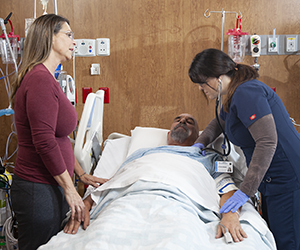The First Few Hours After a Stroke
When you have a stroke, time is crucial. If you have any stroke symptoms, call 911 to be taken to the hospital right away. Don't delay! Don't try to drive yourself to the hospital. The earlier treatment is started after symptoms begin, the more likely you are to survive and recover. Your healthcare provider can be alerted as you are traveling to the hospital. Any relatives or friends who were with you when your symptoms started should go with you to the hospital.
At the emergency room
In the hospital, a healthcare provider will assess your symptoms and will need to know when they occurred. You will also be asked about your health history and risk factors. If they are with you, family or friends can answer if you can't. You will likely have blood tests. You may also have a CT scan or an MRI. This will help determine what kind of stroke you have. The 2 types are blockage (ischemic stroke) or bleeding (hemorrhagic stroke). The type is important to know before treatment is started. This is because treatment that helps an ischemic stroke can kill a person who had a hemorrhagic stroke.

Acute-phase stroke treatment
Treatment can begin as soon as your provider knows what type of stroke you had and where it occurred. Phase 1 begins from the first minutes to the first hours after you begin having symptoms. It involves 1 or more of the following, depending on what kind of stroke you have:
-
Medicine to dissolve clots (ischemic)
-
Medicine to prevent blood clots (ischemic)
-
Intravascular surgery to remove the blood clots (ischemic)
-
Tests to look for damage from the stroke
-
Procedures to stop bleeding (hemorrhagic)
The goal of the acute phase treatment is to minimize brain damage from the stroke. After the first several hours, treatment turns to your recovery and on preventing future strokes.
Symptoms of stroke
Call 911 right away if you have any of the following, even if the symptom seems to get better:
-
Weakness in an arm, hand, or leg
-
Numbness on 1 side of the body
-
Sudden dimness or loss of vision, particularly in 1 eye
-
Sudden trouble speaking
-
Inability to understand what someone is saying
-
Sudden dizziness or loss of balance
-
Sudden, excruciating headache, unlike headaches you’ve had before, or a severe headache accompanied by nausea and vomiting
-
Seizure
B.E.F.A.S.T. is an easy way to remember the signs of a stroke. When you see these signs, you will know that you need to call 911 fast.
B.E.F.A.S.T. stands for:
-
B is for balance. Sudden loss of balance or coordination.
-
E is for eyes. Vision changes in 1 or both eyes.
-
F is for face drooping. One side of the face is drooping or numb. When the person smiles, the smile is uneven.
-
A is for arm weakness. One arm is weak or numb. When the person lifts both arms at the same time, 1 arm may drift downward.
-
S is for speech difficulty. You may notice slurred speech or difficulty speaking. The person can't repeat a simple sentence correctly when asked.
-
T is for time to call 911. If someone shows any of these symptoms, even if they go away, call 911 right away. Make note of the time the symptoms first appeared.
If you are at risk for having a stroke:
-
Keep a list of important phone numbers next to your phone. Include your provider and relatives or friends you want to be contacted.
-
Carry a list of all medicines you take, and the dosage of each, in your wallet. Include over-the-counter medicines, vitamins, and supplements.
-
Write a brief health history, including any other health problems you have had and the dates. Keep this with the medicine list.
Online Medical Reviewer:
Anne Fetterman RN BSN
Online Medical Reviewer:
Heather M Trevino BSN RNC
Online Medical Reviewer:
Jessica Gotwals RN BSN MPH
Date Last Reviewed:
4/1/2024
© 2000-2024 The StayWell Company, LLC. All rights reserved. This information is not intended as a substitute for professional medical care. Always follow your healthcare professional's instructions.